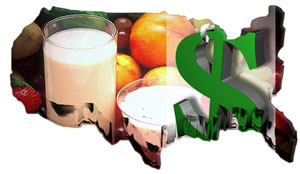-Staff Writer-

WASHINGTON, D.C. (FinalCall.com) – When many people think of hungry children, pictures of India or Africa come to mind, children with distended bellies, sallow eyes and desperate parents. But a new study by Feeding America released last month shows that more children in the United States are hungry than ever before.
“Until now, the number of people falling below the federal poverty threshold has been the indicator most typically used for identifying the need for food at the local level because it is one of the few indicators available at the county level,” explained the report.
“However, national food insecurity data reveal that about 45% of those struggling with hunger actually have incomes above the federal poverty level and 53% of poor households are food secure. Thus, measuring need based on local poverty rates alone provides an incomplete illustration of the potential need for food assistance within our communities.”
Los Angeles, New York and Chicago lead the country as the most food insecure areas. Poverty is the main cause of food insecurity and hunger. In 2007, the official poverty threshold for a family of four with two children was $21,027 per year. In 2007, 13.3 million children lived in poverty and today more than 15 million children live in poverty.
According to the report, food insecurity, which is related to both under nutrition and over-nutrition, impacts nearly one in every five children. In 2007, the most recent year for which data is available, 12.4 million children were food insecure, 16.9 percent of all US children. Younger children are at even greater risk of food insecurity, with 18.9 percent of all children in households with children under six years of age food-insecure in 2007
Janice Glover operates the Food Bank at the Anacostia Community Outreach Center in one of DC’s poorest communities. She witnesses the pain of hungry children everyday.
“We’re seeing more and more children in need. It’s so very hard on the children. We give families enough food to last them at least three days and if it’s a large family we give them enough to last a week. The children stop and ask me if there is anything they can do to make money. They want to buy things,” she told The Final Call.
“Parents just don’t have the incomes to support their children’s needs. It’s very hard out here. I see too many families going without and trying to make ends meet. We need more organizations out here helping families.”
Just what does it mean to be food insecure? Food Insecurity according to the report means, “Limited or uncertain availability of nutritionally adequate and safe foods or limited or uncertain ability to acquire acceptable foods in socially acceptable ways.”
Hunger means, “The uneasy or painful sensation caused by a lack of food. The recurrent and involuntary lack of access to food. Hunger may produce malnutrition over time. … Hunger … is a potential, although not necessary, consequence of food insecurity.”
Hunger and food insecurity are not just about feeding people. They have health and education implications for children.
According to the report, hungry children are sick more often, and more likely to have to be hospitalized (the costs of which are passed along to the business community as insurance and tax burdens); Hungry children suffer growth impairment that precludes their reaching their full physical potential, hungry children incur developmental impairments that limit their physical, intellectual and emotional development.
Hungry children less than 3 years old cannot learn as much, as fast, or as well because chronic under nutrition harms their cognitive development during this critical period of rapid brain growth, actually changing the fundamental neurological architecture of the brain and central nervous system.
Hungry children do more poorly in school and have lower academic achievement because they are not well prepared for school and cannot concentrate; hungry children have more social and behavioral problems because they feel bad, have less energy for complex social interactions, and cannot adapt as effectively to environmental stresses.
“So the sobering message here is that if children don’t have the right experiences during these sensitive periods for the development of a variety of skills, including many cognitive and language capacities, that’s a burden that those kids are going to carry; the sensitive period is over, and it’s going to be harder for them,” explained Jack P. Shonkoff, M.D., Harvard University School of Public Health. “Their architecture is not as well developed in their brain as it would have been if they had the right experiences during the sensitive period. That’s the sobering message.”












